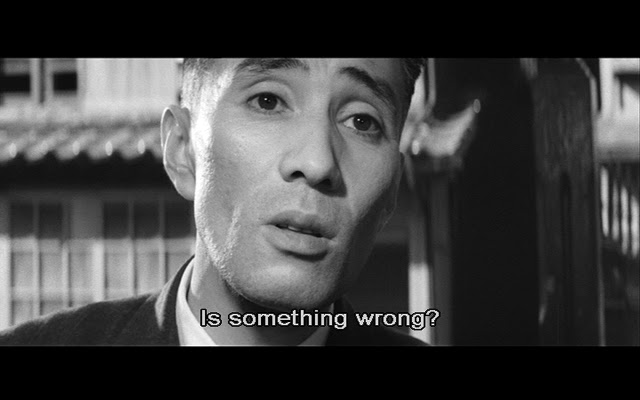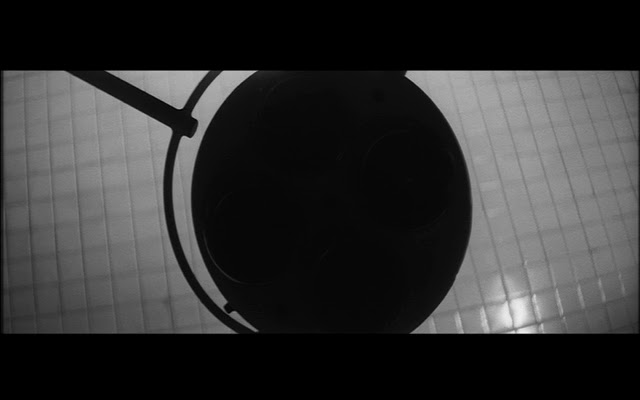One of the most striking things about the films in Criterion/Eclipse’s new Koreyoshi Kurahara set is that – despite their disparity in theme, genre, and tone – they all share an urgent, kinetic style that reminds me of Scorsese at his most gutsy. From the chaotic WARPED ONES to the ostensible romantic dramedy I HATE BUT LOVE, Kurahara never lets his audience feel secure for very long.
Which makes it hard for me to convey Kurahara’s skittering style via the staid still frame showcase that I love so much. But I’m going to try it anyway since I really believe he’s a filmmaker whom young, piss-n-vinegar-filled filmmakers would do well to study. With his Ginsu editing and kamikaze camerawork, Kurahara’s got style to burn (as I say in my review over at GreenCine) and knows how to fill a frame. Here’s a brief, frame grab-heavy tour of the set (and, note well, it contains spoilers).
I. INTIMIDATION
Kurahara’s 65-minute 1960 noir is a perfect genre exercise and my favorite in the set. It’s not as “Kuraharaesque” as THE WARPED ONES or BLACK SUN but it satisfies my personal proclivities: serpentine plot, tight running time, formal dexterity, and contains an indelible character: the born-to-simper Nakaike, played with puppy pathos by Akira Nishimura:
Nishimura wrings every nuance out of the constantly overlooked and belittled Nakaike, revealing the calculating, wounded soul behind those balefull eyes. “Elisha Cook Jr. would have played Nakaike in the US remake” I scrawled in my notes. But there’s a bit more going on upstairs with this guy than, say, Cook’s fall guy in THE KILLING. Which is more than can be said for Nakaike’s boss, Takita, who’s broadly portrayed by Nobuo Kaneko:
And there’s nothing wrong with going broad for Takita. Who doesn’t know that self-assured, gonna-succeed-in-everything-without-trying jerk who’s a shallow ocean of fake camaraderie?
Kurahara wisely plays the pivotal show down between these two former friends as a staring match. Both sets of eyes are all you need to “get” the characters:
One other random regarding INTIMIDATION: Paul Reubens has a small, but important, role:
This is the film in the set I enjoyed the least yet the one I would recommend to anyone who wants to understand Kurahara. It’s a “Sun Tribe Film” (the Japanese equivalent of a youth counterculture piece; think punk or greaser or mod/rocker), depicting the meaningless lives of violent, wayward teenagers, the human detritus left in the wake of a world war and two nuclear bombs. Before I even knew the “Sun Tribe” designation, I wrote “he keeps depicting them as sun worshippers” in my notes.
That’s Akira and his friend Masaru enjoying their recent dismissal from a juvenile prison. It isn’t long before they’re out on the streets, espousing their personal philosophical axioms:
Quests that lead them to brutality:
And art openings:
Another pivotal scene depicts a stand off, where Akira crashes a lunch between an artist and her insufferable boyfriend. Again, Kurahara plays with the inherent discomfort contained within a close-up.
Worried boyfriend:
Worried boyfriend:
The less said about the context here, the better. Let’s just say that Akira wins. Or thinks he does.
I have very little to say about this one. I admire quite a bit about it, particularly the way it waits – WAGES OF FEAR-style – for about 45 minutes before it actually gets its “A-plot” up-and-running. And how it takes a romantic caper and turns it into a nearly silent, extremely introspective road picture.
Two major visuals of interest stick in mind. The numbers, with which the lovelorn Noriko chronicles her Platonic affair with the recalcitrant Daisaku:
I would be very surprised if some designer hadn’t approximated the above scheme into some uber-hip wallpaper, summer dress, Trapper Keeper, whatever.
The other, most obvious, visual asset of note:
Ruriko Asoaka, who lights up every frame she’s in, even when she’s manipulating her lover with a suicide attempt. I’d like to posit an alternative to Godard’s little aphorism: all you need to make a film is a girl and a car.
This is THE WARPED ONES with a sense of purpose. Akira (here named Mei) finds this in jazz (he even has a dog named Monk) …
Backing up, I love how Kurahara sets the desperate, hardscrabble tone of the film with this sci-fi shot of an industrial wasteland:
This notion of a burned up earth (and, perhaps, its attendant black sun) is underlined over and over. When Gill finally reaches his pined-for sea, he discovers a despoiled simulacra of what it once was:
Slick with oil, cluttered with debris. This isn’t some sort of Captain Planetary inconvenient truth meant to cluck its tongue about environment-this and ecology-that.
The corrupted sea and land are wholly intertwined with the post-war corruption of the desperate souls populating the film, Japanese and American alike:
I found BLACK SUN extremely moving, especially in its last section. Akira/Mei ‘s sneer evaporates into a compassionate grimace as he watches his only friend attain the freedom he’s been after.
And, boy-oh-boy, is it attained in the oddest way possible. People on the fence about checking out this should get it for no other reason than to check out the lunatic end to BLACK SUN.
I’d like to end this piece by focusing on a particularly spoilerific scene from THIRST FOR LOVE. First of all, Ruriko Asaoka returns in this film, even more stunning than before:
Trouble is, she’s a monsterous harpy, hell –bent on destroying herself and anyone else she can (literally) get her claws in:
Her Etsuko is one of the most subtly diabolical characters I’ve come across in a long time. By simply remaining quiet, she permits and orchestrates all kind of evils around her. Behind those blank, beautiful eyes is a factory of cruel calculation (cf. Gene Tierney in LEAVE HER TO HEAVEN). She’d be the perfect noir femme fatale if this wasn’t a Mishima adaptation and, therefore, burdened with all of his self-important baggage.
Without saying why she does it, I’m going to go ahead and focus on a scene where Etsuko forces an underling to (again, spoilers are here) have an abortion. The scene is as perfectly harrowing as any horror setpiece, oozing with a clinical malevolence. It’s one of the stand-out sequences in the whole set. And it’s just nine (mostly) silent shots.
The patient’s POV – the light snaps on:
The patient is blindfolded and anaesthetized:
The patient’s boss (and romantic rival) looks on.
The doctor grabs a tool:
Etsuko calmly observes her victim:
The doctor works:
Etsuko watches:
The light goes off:
Cut to a frantic, out-the-window shot of the sun as Etsuko drives her defeated rival back from the hospital. Here the sound jumps, becomes chaotic, the rattling sound of the road ripping into the silence of what we just watched.
Granted, it probably doesn’t translate as well here, where it’s out of context and divorced from the motion so very important to, uh, motion pictures. But it’s a revelatory bit and another perfectly realized set piece in this treasure trove of offbeat filmmaking. I can’t recommend it highly enough. I do suggest going through the set chronologically. And, if you can only afford the time for one of the films, I’d go for BLACK SUN.














































Wonderful collection of screencaps! I am working my way chronologically through the films already, so I concur with your closing advice. I just posted a review of The Warped Ones on CriterionCast.com. Great blog, I'll be coming back for more!
ReplyDeleteDave:
ReplyDeleteNice to get some feedback up in this piece, especially positive and especially for this particular post. Thanks.
I'm a big fan of CriterionCast. Heading over to check your WARPED ONES write-up.
Through no fault of my own, this has become primarily a Criterion-centered blog. At some point this week, I'll be getting to KURONEKO. In the coming weeks, I'll have Sabu and RULES OF THE GAME pieces here and/or over at GreenCine. I hope you'll find them interesting.
Cheers.